
Review
"Pokémon Legends: Z-A" tested: Only mediocre, but I still have fun
by Cassie Mammone

Graphically, the cycling classic makes a big leap, but in terms of gameplay, much remains the same. What the "Pro Cycling Manager 25" improves, what it lacks and why it still motivates me.
Courchevel. Another 9.6 kilometres to the finish on the Col de La Loze. The sun is blazing, the camera shows the day's breakaway group, which has already battled its way over two mountains in the highest category. And in the middle of it all is my rider Marc Hirschi in the jersey of the Swiss Tudor Pro Cycling Team. The small peloton with the Tour favourites around Tadej Pogačar and Jonas Vingegaard is approaching. They are only 2 ½ minutes away.
«It's now or never», I think to myself and instruct Hirschi to attack. He starts with an elegant cradle kick, just like you see on TV. He leaves his rivals Florian Lipowitz and Romain Bardet standing, gaining metre after metre. «Go for it, you have to go for it!» I keep my fingers crossed and sit mesmerised in front of the screen. I can see Hirschi slowly running out of energy, slowing down. Just one kilometre to go, just a few hundred metres. Lipowitz and Bardet have long since been caught by Pogačar. The finish line. At last. Hirschi throws his arms up and I do the same.
18 seconds later, Pogačar follows, then Vingegaard another ten seconds later. I realise now: The underdog from Switzerland, the small Swiss Continental Pro team, has won a Tour stage with its wildcard. The biggest success in the team's history and I am responsible for it as virtual sports director. Welcome to the world of «Pro Cycling Manager 25».
«Pro Cycling Manager 25» (PCM 25 for short) remains true to its lineage. In the 25th year of the traditional Management series, French developer studio Cyanide continues to rely on a mixture of number juggling, squad management and real-time race control. Anyone familiar with the predecessors will quickly find their way around. But this year, the game is taking small but significant steps forward.
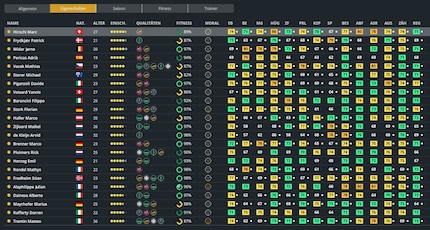
I myself joined the game series in 2005 and spent many years chasing the career of a small team through the racing calendars. Many things still feel the same today as they did back then: the training system, the scouting, the financial management. At times it feels as if the series has become frozen in its own logic. Progress comes in homeopathic doses.
Critically, old features have been removed time and again in recent years, only to be brought back years later as «innovations»: for example, dynamic sponsorship targets, the talent search and extended individual training sessions.
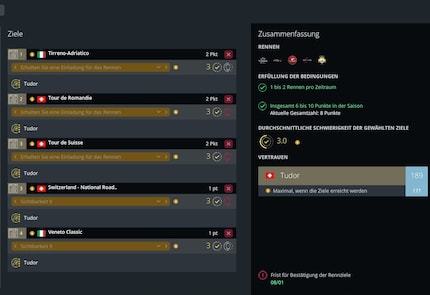
The basic blueprint of the game has hardly changed for two decades. And even if the Management gameplay remains solid, the question is how much longer Cyanide can get away with minimal iteration. Or whether it isn't finally time for bolder reforms.
One thing is immediately noticeable as soon as you click into the first races: The graphics engine has been overhauled. And after years of technical stagnation, this really is a small milestone. Whether it delivers what it promises will be shown in race mode.
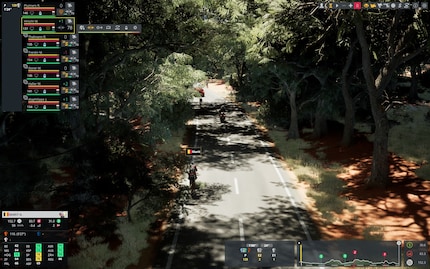
And it really does deliver: the lighting looks more natural, the landscapes are modelled in much greater detail, roads appear more lively and the vegetation more realistic. Especially on stages through fields, villages or forest passages, you finally get the impression of being in the middle of a real cycling scene
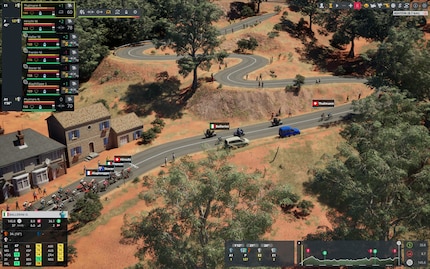
Movement and perspective also benefit from the technical update. Camera movements through the peloton look smoother and the gameplay has more depth. Above all, the play with light and shadow, for example when the time of day changes or when riding through forests, finally creates the atmosphere that the series has long lacked. The rain also finally remains visible on the roads and forms puddles.
Despite the improved graphics, the characters remain the biggest drawback. They still look generic: emotionless, interchangeable, barely animated. In close-ups, many drivers look almost identical. There is also little individualisation when it comes to clothing or driving style. The jerseys, on the other hand, are sharp, clean and now excellently legible.
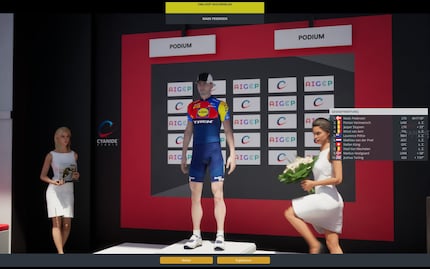
The new user interface has only been slightly modernised and adapted in terms of colour. It presents a lot of data very efficiently, but is not very inviting.
The big problem in 2025 remains the licence situation. Although some top teams are officially represented, many names are placeholders. For example, double Olympic champion Remco Evenepoel will become Remi Edendoel. Without fan mods, the field of riders looks like a parallel world.
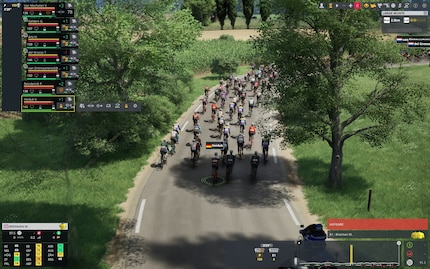
I can unreservedly recommend the mod WorldDB 2025: a comprehensive database with 8500 riders with real names from 140 countries and even more races.
Before that, however, it's worth taking a look at the two main game modes of «PCM 25». In career mode, I take over the management of an existing team: from a small third-class continental team to a World Tour elite ensemble. I am not only the sporting director, but also the manager. Calendar planning, transfers, sponsors, team development and, last but not least, racing are all my responsibility.
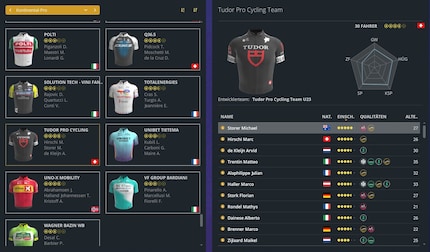
The Pro Cyclist mode, on the other hand, lets me slip into the role of a single rider, whose career I follow from young talent to Tour or Classics winner. The focus here is on role-playing elements: I develop my rider individually, work my way up the team hierarchy and utilise my strengths in races.
Both modes offer different perspectives on everyday cycling and enough depth to keep you hooked for weeks.
I started my career with the Tudor Pro Cycling Team: a young, ambitious continental pro team with Swiss roots, led by ex-pro Fabian Cancellara. «PCM 25» presents itself with great attention to detail, but can often seem cumbersome, especially for newcomers. Planning the race calendar and the form highlights for each individual rider can take some time. However, I can optionally leave this to the game automatically. At the expense of efficiency, of course.
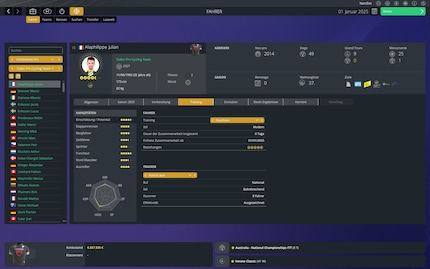

The new sponsor features look fresher than last year. For the first time, I can react more specifically to market interest, which will add a million euros to my budget for the next contract offer.
The training planning has been slightly revised, but still looks more like Excel with racing bikes: efficient, but dry. The appeal comes from the long-term strategy: those who engage with the system are rewarded with the satisfying feeling of having led a Conti team to the Grand Tour.
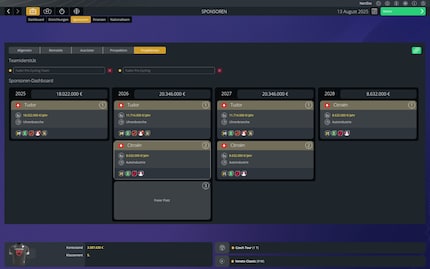
An important aspect of this is the transfer system. In the pre-transfer phase between 1 May and 31 July, I initially have 30 so-called dossier points at my disposal. I can use these to specifically contact riders whose contracts are expiring and increase their interest in my team. Six more points are added on the 15th and 1st of each month, so that a maximum of 60 are available at the end. On 15 June, there are therefore 48 dossier points. The trick is to approach the right drivers early on, plan realistically and use the limited points strategically.
The more interest a rider shows in my team, the better the chances of signing him and the lower his desired salary will be later on. These preliminary negotiations are crucial, because the transfer window opens on 1 August and you have to be quick.
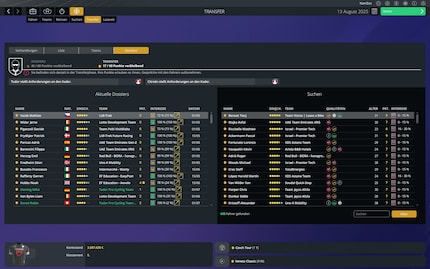
Despite the strategic depth, criticism remains appropriate. Some sequences still seem artificial. Drivers are sometimes unrealistically happy to switch to smaller teams, if only enough interest «was clicked up». The system also lacks personality: there are no agents, no individual reasons for changing teams or emotional components.
The only thing that feels even more mechanical is the talent search. Although I can send scouts to different regions, select age groups and observe the potential, there is rarely any real desire to discover. The names of the youth riders are generic, the presentation sober, and the scouting experience lags far behind the genre giants of other sports.
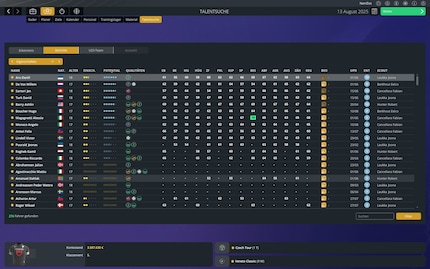
For my second score, I chose the Pro Cyclist mode. I opted for a profile that would open up opportunities for me on short climbs as well as in sprints: Puncheur, with sprinter as my second speciality.
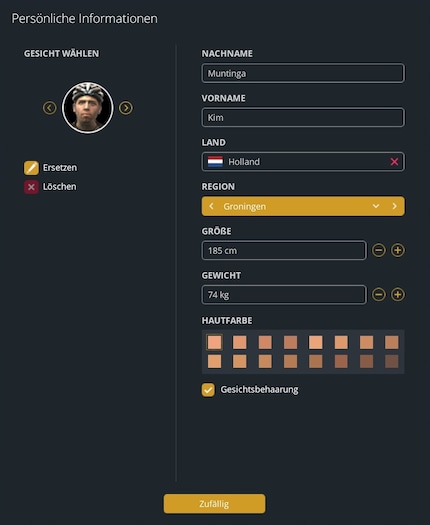
After the rather generic character editor, I end up at Uno-X Mobility, a Norwegian continental professional team focussing on talent development. The start is realistic: in the first few months, I ride smaller races, mainly take on helper roles and am rarely in breakaway groups. Instead, I protect my captain or lead the peloton to catch up with the breakaways. Real successes are few and far between.
But: The role-playing elements work well here. By performing well in the race, achieving goals and behaving well in the team, I increase my reputation and develop attributes. Nevertheless, «PCM» remains true to its line here too. Emotions and presentation are minimal, there is no dialogue and the personal career is more a numbers game than storytelling.
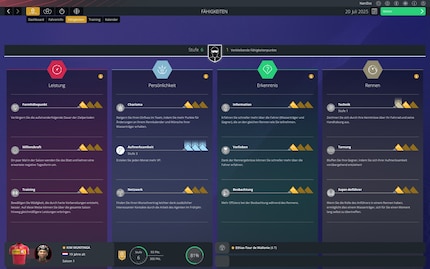
In principle, I like the Pro Cyclist mode. However, I noticed a bug in the talent development that massively disrupts the flow of the game. In my career as a puncheur with Uno-X Mobility, I was only able to develop my main speciality «Puncheur» at every single talent level.
Normally, the system should allow me to choose between different specialisations with each new level, so that I can also focus on my climbing or sprinting ability in the short term. This is not only frustrating, but also problematic in terms of game mechanics, as it prevents you from developing a balanced rider profile.
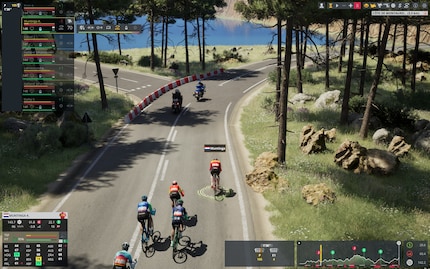
I hope Cyanide tackles this problem quickly. The Pro Cyclist mode thrives on long-term progression and customisation.
Race control remains the centrepiece of «Pro Cycling Manager 2025» and it works as well as ever: I control rider positions, energy management, attacks, nutrition and speed work in real time. Every click counts. A badly timed sprint or an early breakaway attempt can cost you an entire race. The controls are complex but precise. With the necessary experience, it becomes second nature.
Before the start, I select my riders, study profiles, compare form values and decide on roles: Captain, breakaway rider, helper. In the stage itself, micromanagement is required: utilising slipstreams, timing food, planning attacks and/or the sprint train.
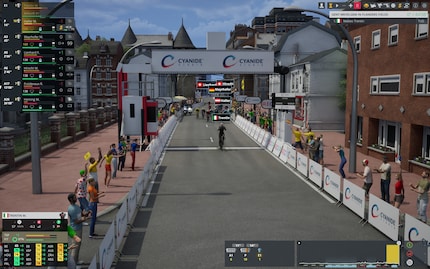
The AI itself drives better than in previous years, especially in stages with windy sections or difficult final climbs. Nevertheless, some races remain too predictable. Breakaway groups are reliably caught, sprint trains often behave mechanically.
However, I always had exciting moments: a rider breaking away on the descent, a failed sprint, an unexpected stage win thanks to clever positioning. «PCM 25» manages to combine strategy and drama in a credible way if you familiarise yourself with the system.
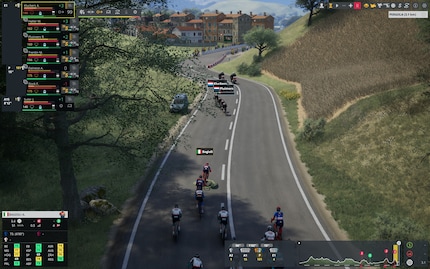
The main new feature in 2025 is the ability to fine-tune the difficulty of the race. The game can be customised on a modular basis in the career menu: In addition to the general difficulty level (for example, hard), individual parameters such as sponsor pressure, transfer hardness, time trials, sprint quality of the opponents or my financial framework conditions influence the game experience.
Even more interesting are the new advanced controls for the race itself: I can set a factor for the effect of terrain attributes (from 0 to 2 in increments of 0.1) as well as on stamina and toughness values for daily races or tours (0 to 3 in increments of 0.1). This allows targeted tuning for more realistic and challenging games. The latter made my life particularly difficult in Pro Cyclist mode.
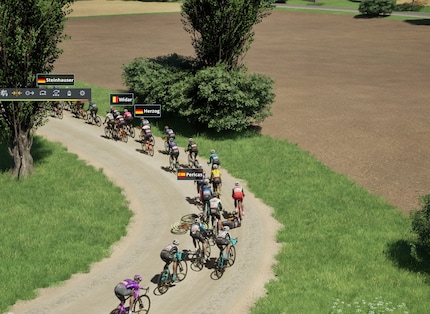
The «Pro Cycling Manager 25» is not a game for in-between. It requires planning, patience and a love of tactics. Those who get involved can invest dozens of hours. Cycling fans in particular will be thrilled. At the same time, I know a few people who have discovered their love of cycling through the game. Last year, I invested almost 720 hours in the predecessor. I'm currently at 40 hours of gameplay for this review and I haven't even started my long-term save yet.
«Pro Cycling Manager 25» has been available for PC since 5 June.
"Pro Cycling Manager 2025" remains what it has been for years: an in-depth management simulation for cycling nerds. Full of detail, bulky, old-fashioned and fascinating at the same time. The biggest innovation is the visibly improved graphics, which finally give the game a more modern presentation after years of stagnation. It brings significantly more atmosphere to the racing action.
In terms of content, everything remains the same. And that's a good thing for the most part. The combination of complex micromanagement, intensive career planning and precise real-time tactics continues to unfold its very own charm. The more dynamic sponsor requirements are a welcome innovation.
Nevertheless: Cyanide once again misses the opportunity to give the franchise a bold innovation boost. Much of the game still plays exactly as it did 10, 15 or even 20 years ago. The scouting system, i.e. the talent search, remains too mechanical and generic. It lacks personality, chance and real moments of discovery. The equipment and material system has also had little real impact on the racing action for years and seems more like a neglected backdrop.
In addition, there is hardly any interaction with the drivers or other employees. Personalities, team dynamics and other aspects are completely absent.
Despite everything, I remain a fan of the series. Anyone who loves cycling will lose many hours again in "Pro Cycling Manager 2025". But I ask myself: when will Cyanide finally dare to be really bold?
Pro
Contra
My interests are varied, I just like to enjoy life. Always on the lookout for news about darts, gaming, films and series.
Which films, shows, books, games or board games are genuinely great? Recommendations from our personal experience.
Show all